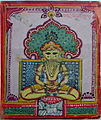| Shreyansanatha | |
|---|---|
| 11th Jain Tirthankara | |
 Shri Shreyansnath Bhagwan at Shri Sinhapuri Tirth, Sarnath, UP. Shri Shreyansnath Bhagwan at Shri Sinhapuri Tirth, Sarnath, UP. | |
| Venerated in | Jainism |
| Predecessor | Shitalanatha |
| Successor | Vasupujya |
| Symbol | Rhinoceros |
| Height | 80 bows (240 meters) |
| Age | 8,400,000 years |
| Color | Golden |
| Genealogy | |
| Born | Sarnath |
| Died | Shikharji |
| Parents |
|
| Part of a series on |
| Jainism |
|---|
 |
| Philosophy |
EthicsEthics of Jainism
|
| Jain prayers |
| Major figures |
| Major sectsSchools and Branches |
| Jain literature |
| Festivals |
| PilgrimagesTirth |
| Other |
Shreyansanath was the eleventh Jain Tirthankara of the present age (Avasarpini). According to Jain beliefs, he became a Siddha – a liberated soul which has destroyed all of its karma. Shreyansanatha was born to King Vishnu and Queen Vishna at Simhapuri, near Sarnath in the Ikshvaku dynasty. His birth date was the twelfth day of the Falgun Krishna month of the Indian calendar.
Teachings on Nirjara
Shreyansnath Swami's teachings emphasized Nirjara, the discharge of karmas. He explained that karmas are in stages of charging and discharging, with Nirjara being the stage of discharge. He distinguished between Akaam Nirjara (discharge without purpose) and Sakaam Nirjara (discharge with purpose). For a self-realized person, Sakaam Nirjara ensures that no new karmas are charged, as they remain vigilant in their awareness of being a Knower and Seer.
Shreyansnath also highlighted the importance of penance (tapa) in achieving Sakaam Nirjara. He categorized penance into two types: Bahya Tapa (external penance) and Abhyantar Tapa (internal penance).
Bahya Tapa
The six types of Bahya Tapa are:
- Anshan (fasting)
- Unodari (eating less)
- Vrutti Sankshep (limiting desires)
- Ras Tyag (abstaining from taste)
- Kayotsarg (meditation)
- Sanlinta (modesty)
Abhyantar Tapa
The six types of Abhyantar Tapa are:
- Prayashchit (repentance)
- Vaiyavach (service to saints)
- Swadhyay (study of the self)
- Vinay (humility)
- Vyutsarg (renunciation)
- Dhyan (meditation)
Through Abhyantar Tapa, true karmic shedding occurs. Practices like Prayashchit help cleanse sins, while maintaining equanimity and viewing others as innocent aids in achieving liberation.
Nirvana
Shreyansnath Bhagwan's Deshna inspired many to take Diksha and achieve Keval-Gnan and Moksha (liberation). He attained Nirvana from Sammed Shikharji Mountain, along with many Sadhus, Sadhvis, Shravakas, and Shravikas.
Main Temple
The Sarnath Jain Tirth temple located at Sarnath, Varanasi is one of the main shrines of Shreyansanatha.
Gallery
-
 Sridigamber Jain Temple, Simhapuri, Sarnath, near Varanasi, the birthplace of Shreyansanath.
Sridigamber Jain Temple, Simhapuri, Sarnath, near Varanasi, the birthplace of Shreyansanath.
-
 Gouche and Silver on paper painting, Gujarat, 18th century.
Gouche and Silver on paper painting, Gujarat, 18th century.
-
 Shreyanasanatha idol in Bhand Dewal along with Neminatha and Ajitnatha dated back to 9th century
Shreyanasanatha idol in Bhand Dewal along with Neminatha and Ajitnatha dated back to 9th century
-
 Shreyansanath Tonk, Shikharji
Shreyansanath Tonk, Shikharji
-
 Footprint at Shreyansanath Tonk, Shikharji
Footprint at Shreyansanath Tonk, Shikharji
See also
Notes
- Tandon, Om Prakash (2002) , Jaina Shrines in India (1 ed.), New Delhi: Publications Division, Ministry of Information and Broadcasting, Government of India, pp. 44–5, ISBN 81-230-1013-3
- ^ Tukol 1980, p. 31.
References
- Johnson, Helen M. (1931), Shreyamsanathacaritra (Book 4.1 of the Trishashti Shalaka Purusha Caritra), Baroda Oriental Institute
- Tukol, T. K. (1980), Compendium of Jainism, Dharwad: Karnatak University
| Gods | |||||
|---|---|---|---|---|---|
| Philosophy | |||||
| Branches |
| ||||
| Practices | |||||
| Literature | |||||
| Symbols | |||||
| Ascetics | |||||
| Scholars | |||||
| Community | |||||
| Jainism in |
| ||||
| Jainism and | |||||
| Dynasties and empires | |||||
| Related | |||||
| Lists | |||||
| Navboxes | |||||
This biography of an Indian religious figure is a stub. You can help Misplaced Pages by expanding it. |
This Jainism-related article is a stub. You can help Misplaced Pages by expanding it. |